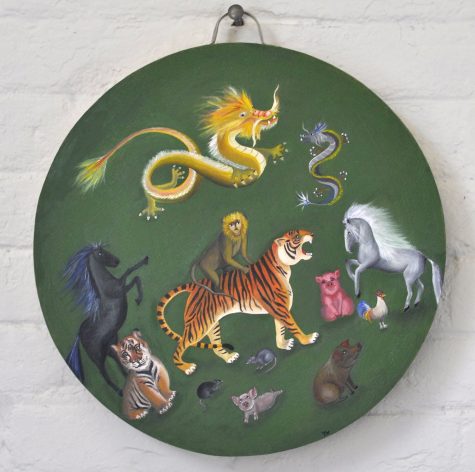‘Artists in Conversation’ panel addresses isolation felt by immigrants
Gohar Dashti’s piece “Untitled 1” is now on display at the Scottsdale Museum of Contemporary Art in Scottsdale, Arizona. With this piece, Dashti aimed to explore the themes of displacement and home. Photo courtesy Gohar Dashti.
February 22, 2023
Artists Mimi Bai, Gohar Dashti and Ngoc-Tran Vu all share a common experience — they immigrated to the U.S. at a young age and started a journey that proved to be harder than they expected.
“Those of us who came to this country as children are neither of our original culture or of the new culture. So we don’t fit,” said Vu, a local artist who emphasizes community, family and culture in her artwork.
Vu, alongside Bai, the artist behind the “HIDE and SEE” short film and exhibit at the Mills Gallery at the Boston Center for the Arts, and Dashti, a photographer specializing in nature, spoke to a crowd at the Pao Arts Center Jan. 28 about how their artwork captures ideas of community, migration and home, and just how difficult it is to navigate a life split between two cultures.
“I think oftentimes, as people of color, we are marginalized,” Vu said. “Our connections with our culture are severed and that is when intergenerational trauma happens.”

Vu continued with an anecdote about her piece “Family Portrait.” The piece was painted on a 13-inch cutting board and depicts her extended family. Vu was born in Vietnam before coming to the U.S. as a child, and she wanted to emphasize her Vietnamese roots and show a “different kind of narrative” than a traditional family portrait.
“I was thinking about this idea of reframing my family using the Vietnamese zodiac,” Vu said. “My parents are the monkey and tiger, and the rest of my family surrounds them.”
Following Vu’s presentation, Dashti displayed her photography of nature and explained how the work plays into the idea of culture and how that is shown through the everyday actions of a person.
“When we understand culture is when we understand nature more,” Dashti said. “I used to feel that nature and culture were protection, but now I see nature and culture as motivation.”
In a majority of her artwork, Dashti looks to explore the themes of displacement and home in large-scale pieces. Dashti creates panels ranging in size that each represent a different landscape of nature. After she creates panels, she ships them to the location where she plans to photograph them.
In her piece “Untitled 1,” Dashti expresses her view of nature. When a person looks at her art, it is clear the panel is an art piece, but it still blends in with its surroundings. This imagery is a metaphor for how she felt emigrating from her country. The piece shows that even though she fits into the scenery of her culture, something still sets her apart, making her feel like an imposter.
“I traveled for two years in many different places to find a connection,” Dashti said. “I just wanted to find myself walking into nature. Nature is borderless, so that is what my next project is all about.”
Dashti’s project is similar to Bai’s “HIDE and SEEK.” The main focus of this short film is camouflage as a representation of the cultural assimilation she felt pressured to undergo as an immigrant.
“The process of assimilation was the central focus that came out of this experience of immigrating here,” Bai said. “So when I started doing this work and thinking about camouflage, I guess it was really a metaphor for assimilation because it’s about concealing, protecting oneself and being invisible.”
Bai continues by using the metaphor of a hunter in the woods during autumn. The hunter and the deer, in the context of the metaphor, represent her experience with cultural assimilation. Depending on her surroundings, Bai feels either ignored or exposed, illustrating the duality of life as an immigrant.
“He wears orange to blend in with the leaves and the foliage,” she said. “So now, the deer cannot see him and he is camouflaged. But then when winter comes, the deer can see him, and he is no longer camouflaged. That is what I tried to convey through this short film, that even though someone is camouflaged, they can still be hypervisible in a different environment.”
The film illustrates how Bai feels in her own culture, and Dashti agrees that even though sometimes she feels she belongs, there are still other times when she feels alienated.
In her piece “Alien,” Dashti confesses that even when she is home, she still feels like an outsider. “Alien” is a photograph she took in the woods of a shrubbery landscape, a trickling river and a big black box hovering in the middle of the photo.
“In New Hampshire, my studio was in the middle of the woods. When I started to watch the nature around me, I didn’t feel safe,” Dashti said. “The connection felt different because we had two different roots. With this project, I just wanted to understand the nature and the space between me and the nature. The box is an alien. It doesn’t fit in with the nature surrounding it.”
Like Dashti, Vu is still struggling with finding her cultural identity, however, she is optimistic about her path, and the path of her community, to find their place within their culture and in the U.S.
“We are all navigating life in our own kind of journeys in ways that are sometimes visible and sometimes invisible,” she said. “Culture and society are always putting on me, so being able to know I am not bound to certain things is the first step to countering individualism and rebuilding interconnectivity.”







